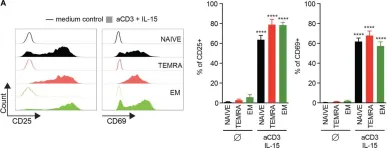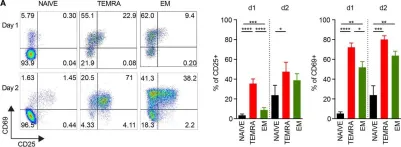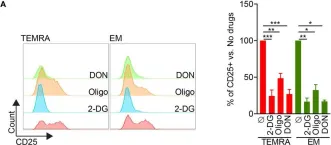We developed viral sensor and restriction factor-cytometry by time of flight (VISOR-CyTOF), which profiles 19 viral sensors and restriction factors (VISORs) simultaneously in single cells, and applied it to 41 postmortem tissues from people with HIV. Mucosal myeloid cells are well equipped with SAMHD1 and sensors of viral capsid and DNA while CD4+ T cells are not. In lymph node CD4+ Tfh, VISOR expression patterns reflect those favoring integration but blocking HIV gene expression, thus favoring viral latency. We also identify small subsets of bone marrow-, lung-, and gut-associated CD4+ T and myeloid cells expressing high levels of restriction factors targeting most stages of the HIV replication cycle. In vitro, HIV preferentially fuses to CD4+ T cells with a permissive VISOR profile, but early induction of select VISORs by T1IFN prevents productive HIV infection. Our findings document the diverse patterns of VISOR profiles across tissues and cellular subsets and define their association with susceptibility to HIV.
Copyright © 2024 The Authors. Published by Elsevier Inc. All rights reserved.
Product Citations: 61
Anatomical, subset, and HIV-dependent expression of viral sensors and restriction factors.
In Cell Reports on 28 January 2025 by George, A. F., Neidleman, J., et al.
-
Immunology and Microbiology
In eLife on 5 July 2022 by Ma, T., McGregor, M., et al.
High-parameter single-cell phenotyping has enabled in-depth classification and interrogation of immune cells, but to date has not allowed for glycan characterization. Here, we develop CyTOF-Lec as an approach to simultaneously characterize many protein and glycan features of human immune cells at the single-cell level. We implemented CyTOF-Lec to compare glycan features between different immune subsets from blood and multiple tissue compartments, and to characterize HIV-infected cell cultures. Using bioinformatics approaches to distinguish preferential infection of cellular subsets from viral-induced remodeling, we demonstrate that HIV upregulates the levels of cell-surface fucose and sialic acid in a cell-intrinsic manner, and that memory CD4+ T cells co-expressing high levels of fucose and sialic acid are highly susceptible to HIV infection. Sialic acid levels were found to distinguish memory CD4+ T cell subsets expressing different amounts of viral entry receptors, pro-survival factors, homing receptors, and activation markers, and to play a direct role in memory CD4+ T cells' susceptibility to HIV infection. The ability of sialic acid to distinguish memory CD4+ T cells with different susceptibilities to HIV infection was experimentally validated through sorting experiments. Together, these results suggest that HIV remodels not only cellular proteins but also glycans, and that glycan expression can differentiate memory CD4+ T cells with vastly different susceptibility to HIV infection.
© 2022, Ma et al.
Functional analysis of human circulating immune cells based on high-dimensional mass cytometry.
In STAR Protocols on 17 June 2022 by Liu, X., Lv, J., et al.
With the advantages of high resolution and high dimension, mass cytometry is implemented to analyze the blood complex immune system in clinical settings. However, long-term clinical sample collection may cause batch effects that mask true biological results. Here, we present a validated and streamlined mass cytometry workflow that features fixed staining for clinical use and optimized barcode staining patterns. The reagents and approaches used in this workflow can help reduce batch effects, thereby extending the application range and advantages of mass cytometry.
© 2022 The Author(s).
-
Homo sapiens (Human)
-
Immunology and Microbiology
Enhanced safety and efficacy of protease-regulated CAR-T cell receptors.
In Cell on 12 May 2022 by Labanieh, L., Majzner, R. G., et al.
Regulatable CAR platforms could circumvent toxicities associated with CAR-T therapy, but existing systems have shortcomings including leakiness and attenuated activity. Here, we present SNIP CARs, a protease-based platform for regulating CAR activity using an FDA-approved small molecule. Design iterations yielded CAR-T cells that manifest full functional capacity with drug and no leaky activity in the absence of drug. In numerous models, SNIP CAR-T cells were more potent than constitutive CAR-T cells and showed diminished T cell exhaustion and greater stemness. In a ROR1-based CAR lethality model, drug cessation following toxicity onset reversed toxicity, thereby credentialing the platform as a safety switch. In the same model, reduced drug dosing opened a therapeutic window that resulted in tumor eradication in the absence of toxicity. SNIP CARs enable remote tuning of CAR activity, which provides solutions to safety and efficacy barriers that are currently limiting progress in using CAR-T cells to treat solid tumors.Copyright © 2022 The Authors. Published by Elsevier Inc. All rights reserved.
-
Immunology and Microbiology
In Frontiers in Immunology on 6 July 2021 by Huot, N., Rascle, P., et al.
CD4 T cell responses constitute an important component of adaptive immunity and are critical regulators of anti-microbial protection. CD4+ T cells expressing CD32a have been identified as a target for HIV. CD32a is an Fcγ receptor known to be expressed on myeloid cells, granulocytes, B cells and NK cells. Little is known about the biology of CD32+CD4+ T cells. Our goal was to understand the dynamics of CD32+CD4+ T cells in tissues. We analyzed these cells in the blood, lymph nodes, spleen, ileum, jejunum and liver of two nonhuman primate models frequently used in biomedical research: African green monkeys (AGM) and macaques. We studied them in healthy animals and during viral (SIV) infection. We performed phenotypic and transcriptomic analysis at different stages of infection. In addition, we compared CD32+CD4+ T cells in tissues with well-controlled (spleen) and not efficiently controlled (jejunum) SIV replication in AGM. The CD32+CD4+ T cells more frequently expressed markers associated with T cell activation and HIV infection (CCR5, PD-1, CXCR5, CXCR3) and had higher levels of actively transcribed SIV RNA than CD32-CD4+T cells. Furthermore, CD32+CD4+ T cells from lymphoid tissues strongly expressed B-cell-related transcriptomic signatures, and displayed B cell markers at the cell surface, including immunoglobulins CD32+CD4+ T cells were rare in healthy animals and blood but increased strongly in tissues with ongoing viral replication. CD32+CD4+ T cell levels in tissues correlated with viremia. Our results suggest that the tissue environment induced by SIV replication drives the accumulation of these unusual cells with enhanced susceptibility to viral infection.
Copyright © 2021 Huot, Rascle, Planchais, Contreras, Passaes, Le Grand, Beignon, Kornobis, Legendre, Varet, Saez-Cirion, Mouquet, Jacquelin and Müller-Trutwin.
-
Immunology and Microbiology
In Front Immunol on 18 July 2017 by Tilly, G., Doan-Ngoc, T. M., et al.
Fig.1.A

-
FC/FACS
-
Collected and cropped from Front Immunol by CiteAb, provided under a CC-BY license
Image 1 of 3
In Front Immunol on 18 July 2017 by Tilly, G., Doan-Ngoc, T. M., et al.
Fig.2.A

-
FC/FACS
-
Collected and cropped from Front Immunol by CiteAb, provided under a CC-BY license
Image 1 of 3
In Front Immunol on 18 July 2017 by Tilly, G., Doan-Ngoc, T. M., et al.
Fig.6.A

-
FC/FACS
-
Collected and cropped from Front Immunol by CiteAb, provided under a CC-BY license
Image 1 of 3


